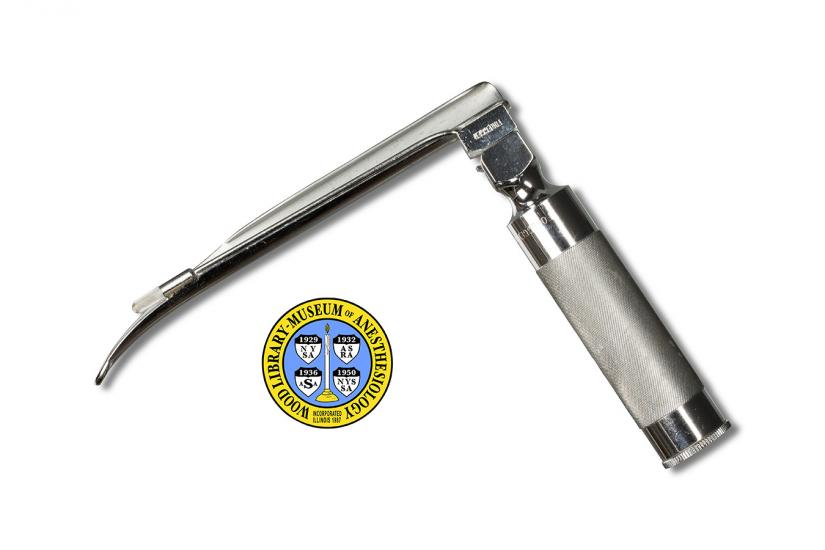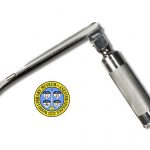Miller Laryngoscope
For surgeries that require general anesthesia, anesthesiologists often need to insert a plastic tube into a patient's trachea (windpipe) to maintain an open airway and assist breathing. One of the tools used to do this is a laryngoscope, used to view the larynx (voice box), which is the opening to the trachea and lungs. The "blade" of the laryngoscope goes into the patient's mouth, acting as a tongue depressor and a viewing channel for placing the tube.
Dr. Robert A. Miller (1906-1976) introduced his laryngoscope in 1941, when the technique of endotracheal intubation was becoming increasingly common. It has a straight blade with a long, curved tip, giving better exposure of the larynx. This and other features of the design made difficult intubations easier to perform before the widespread use of muscle relaxants. Originally made only in size 2 (medium), the blade is now available in sizes from 0 (premature) through 5. The Miller laryngoscope is the most popular straight-bladed laryngoscope in use today.
Catalog Record: Miller Laryngoscope
Access Key: ales
Accession No.: 2014-02-11-2
Title: [ Miller laryngoscope.]
Author: Miller, Robert Arden, 1906-1976.
Publisher: [Roslyn, New York]; Foregger, [between 1941 and 1960?].
Physical Descript: 1 laryngoscope : metals, glass ; 17.5 x 3.5 x 21 cm.
Subject: Laryngoscopes – straight blades.
Subject: Laryngoscopes – battery-powered.
Subject: Laryngoscopy.
Subject: Airway Management – instrumentation.
Subject: Airway Management Equipment.
Subject: Intubation, Intratracheal – instrumentation.
Subject: Miller, Robert Arden, 1906-1976.
Note Type: General
Notes: The early year in the date range for the possible year of manufacture is
based on the year that Dr. Miller introduced his laryngoscope; The end date
is based on a marking on the blade, “FOREGGER FOLDING SCOPE,” and Foregger
Company catalogs. The term, “Folding ‘Scope” is used in the 1942 and 1949
catalogs, but not in the 1959 catalog. The date range could change if
documentation, or expert opinion, indicates that it should be corrected.
Note Type: Citation
Notes: Catalog No. 8. New York: The Foregger Company, Inc.; 1942:90.
Note Type: Citation
Notes: Catalog No. 9. New York: The Foregger Company, Inc.; 1949:104.
Note Type: Citation
Notes: Catalog No. 15. Roslyn Heights: New York; 1959. [The term “folding Scope” is
not used in the 1959 catalog.]
Note Type: Physical Description
Notes: One folding laryngoscope with a straight blade; The measurements and this
description are based on a patient’s perspective; The blade is detachable,
and slightly curved at the most proximal end; The bald is marked, “MILLER
[new line] 4” on one side, and “FOREGGER” on the other; A small light built
is located on the proximal end of the blade; The handle is made for size “C”
batteries; The body of the handle is knurled; The body of the handle is
marked “FOREGGER FOLDING SCOPE”; The end of the handle where the blade
attaches is marked, “NORTH LOCAL ROOM”.
Note Type: Reproduction
Notes: Photographed by Mr. Steve Donisch, February 11, 2014.
Note Type: Historical
Notes: For surgeries that require general anesthesia, anesthesiologists often need
to insert a plastic tube into a patient’s trachea (windpipe) to maintain an
open airway and assist breathing. One of the tools used to do this is a
laryngoscope, used to view the larynx (voice box), which is the opening to
the trachea and lungs. The “blade” of the laryngoscope goes into the
patient’s mouth, acting as a tongue depressor and a viewing channel for
placing the tube.
Dr. Robert A. Miller (1906-1976) introduced his laryngoscope in 1941, when
the technique of endotracheal intubation was becoming increasingly common.
It has a straight blade with a long, curved tip, giving better exposure of
the larynx. This and other features of the design made difficult
intubations easier to perform before the widespread use of muscle relaxants.
Originally made only in size 2 (medium), the blade is now available in sizes
from 0 (premature) through 5. The Miller laryngoscope is the most popular
straight-bladed laryngoscope in use today.
Note Type: Exhibition
Notes: Selected for the WLM website.


